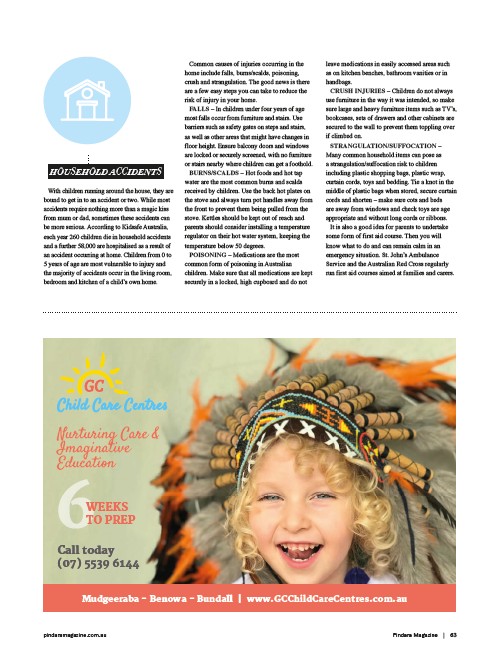
HOUSEHOLD ACCIDENTS
With children running around the house, they are
bound to get in to an accident or two. While most
accidents require nothing more than a magic kiss
from mum or dad, sometimes these accidents can
be more serious. According to Kidsafe Australia,
each year 260 children die in household accidents
and a further 58,000 are hospitalised as a result of
an accident occurring at home. Children from 0 to
5 years of age are most vulnerable to injury and
the majority of accidents occur in the living room,
bedroom and kitchen of a child’s own home.
Common causes of injuries occurring in the
home include falls, burns/scalds, poisoning,
crush and strangulation. The good news is there
are a few easy steps you can take to reduce the
risk of injury in your home.
FALLS – In children under four years of age
most falls occur from furniture and stairs. Use
barriers such as safety gates on steps and stairs,
as well as other areas that might have changes in
floor height. Ensure balcony doors and windows
are locked or securely screened, with no furniture
or stairs nearby where children can get a foothold.
BURNS/SCALDS – Hot foods and hot tap
water are the most common burns and scalds
received by children. Use the back hot plates on
the stove and always turn pot handles away from
the front to prevent them being pulled from the
stove. Kettles should be kept out of reach and
parents should consider installing a temperature
regulator on their hot water system, keeping the
temperature below 50 degrees.
POISONING – Medications are the most
common form of poisoning in Australian
children. Make sure that all medications are kept
securely in a locked, high cupboard and do not
leave medications in easily accessed areas such
as on kitchen benches, bathroom vanities or in
handbags.
CRUSH INJURIES – Children do not always
use furniture in the way it was intended, so make
sure large and heavy furniture items such as TV’s,
bookcases, sets of drawers and other cabinets are
secured to the wall to prevent them toppling over
if climbed on.
STRANGULATION/SUFFOCATION –
Many common household items can pose as
a strangulation/suffocation risk to children
including plastic shopping bags, plastic wrap,
curtain cords, toys and bedding. Tie a knot in the
middle of plastic bags when stored, secure curtain
cords and shorten – make sure cots and beds
are away from windows and check toys are age
appropriate and without long cords or ribbons.
It is also a good idea for parents to undertake
some form of first aid course. Then you will
know what to do and can remain calm in an
emergency situation. St. John’s Ambulance
Service and the Australian Red Cross regularly
run first aid courses aimed at families and carers.
Nurturing Care &
Imaginative
Education
WEEKS
TO PREP
Call today
(07) 5539 6144
Mudgeeraba - Benowa - Bundall | www.GCChildCareCentres.com.au
pindaramagazine.com.au Pindara Magazine | 63